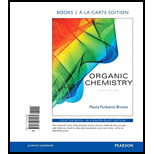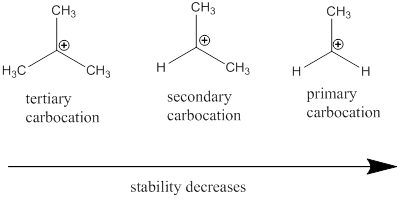
(a)
Interpretation:
From the given compounds, the compound with high regioselective ability towards addition of
Concept introduction:
Addition Reaction: It is defined as
The product of electrophilic addition reaction obtained by addition of electrophile to
Electrophile: Electrophiles are electron deficient compounds which accepts electrons from nucleophiles that results in bond formation.
Leaving group: it is a fragment that leaves substrate with a pair of electrons via heterolytic bond cleavage.
Chemical reaction involves bond making and breaking of two or more reactants in order to attain products from the reactants.
Cation: The positively charged chemical species is referred as cation.
Regioselective reaction: They are reactions which contain more than one product which are actually molecules with same molecular formula but different in the way they are connected and among those products only one product is major.
(b)
Interpretation:
From the given compounds, the compound with high regioselective ability towards addition of
Concept introduction:
Addition Reaction: It is defined as chemical reaction in which two given molecules combines and forms product. The types of addition reactions are electrophilic addition, nucleophilic addition, free radical additions and cycloadditions. Generally, compounds with carbon-hetero atom bonds favors addition reaction.
The product of electrophilic addition reaction obtained by addition of electrophile to
Electrophile: Electrophiles are electron deficient compounds which accepts electrons from nucleophiles that results in bond formation.
Leaving group: it is a fragment that leaves substrate with a pair of electrons via heterolytic bond cleavage.
Chemical reaction involves bond making and breaking of two or more reactants in order to attain products from the reactants.
Cation: The positively charged chemical species is referred as cation.
Regioselective reaction: They are reactions which contain more than one product which are actually molecules with same molecular formula but different in the way they are connected and among those products only one product is major.

Want to see the full answer?
Check out a sample textbook solution
Chapter 6 Solutions
Organic Chemistry, Books a la Carte Edition (8th Edition)
- 5.66 A mixture contains equal amounts of compounds A-D. A B C a. Which compounds alone are optically active? b.If the mixture was subjected to fractional distillation, how many fractions would be obtained? c. How many of these fractions would be optically active?arrow_forwardWhat contributes to the deactivating nature of halides inelectrophilic aromatic substitution? a. inductive effect b. octet rule c. delocalization of electron pairarrow_forwardWhich of the following does not undergo conjugate addition with butanamine? a. Propenal b. But-2-enal c. But-3-enal d. Butenonearrow_forward
- Which compound is not aromatic? A. only A and D B. A, B and C C. only B D. only Aarrow_forwardWhich molecule is hydrolyzed most slowly with aqueous NaOH? D. C. В. A.arrow_forwardElectrophilic Addition Soubong neblA-aleid rose 9160910 31 babeen ene singo 14.43 Draw the products formed when each compound is treated with one equivalent of HBr. a. b. C.arrow_forward
- 2. For each pair of the following compounds, identify which compound and conditions would react more rapidly in SN2 reaction? Briefly explain the deciding factor. A. B. C. F Loti L Br OTf KOH methanol CI KOH acetonearrow_forwardTo what do you attribute the deactivating nature of halides in electrophilic aromatic substitution? octet rule a. b. inductive effect delocalization of electron pair C.arrow_forward1. a. 4-methoxybenzoic acid is less or more polar than 4-methoxyacetophenone? explain why (WITHOUT DRAWINGS) b. 3′-chloro-4′-methoxyacetophenone is less or more polar than 4-methoxyacetophenone? explain why (WITHOUT DRAWINGS) 2. a. 4-methoxybenzoic acid has a higher melting point than 4-methoxyacetophenone. explain why? (WITHOUT DRAWINGS) b. 3′-chloro-4′-methoxyacetophenone has a higher melting point than 4-methoxyacetophenone. explain why? (WITHOUT DRAWINGS)arrow_forward
- Explain why compound A is much more stable than compound B. A Barrow_forwardChemistry 5.66 A mixture contains equal amounts of compounds A-D. D B C A a. Which compounds alone are optically active? b. If the mixture was subjected to fractional distillation, how many fractions would be obtained? c. How many of these fractions would be optically active?arrow_forward2. How many different ß-hydroxyaldehydes and ß-hydroxyketones, including constitutional isomers and stereoisomers, are formed upon treatment of a mixture of acetone and benzaldehyde with base? a. b. 2 c. 3 d. 4arrow_forward
 ChemistryChemistryISBN:9781305957404Author:Steven S. Zumdahl, Susan A. Zumdahl, Donald J. DeCostePublisher:Cengage Learning
ChemistryChemistryISBN:9781305957404Author:Steven S. Zumdahl, Susan A. Zumdahl, Donald J. DeCostePublisher:Cengage Learning ChemistryChemistryISBN:9781259911156Author:Raymond Chang Dr., Jason Overby ProfessorPublisher:McGraw-Hill Education
ChemistryChemistryISBN:9781259911156Author:Raymond Chang Dr., Jason Overby ProfessorPublisher:McGraw-Hill Education Principles of Instrumental AnalysisChemistryISBN:9781305577213Author:Douglas A. Skoog, F. James Holler, Stanley R. CrouchPublisher:Cengage Learning
Principles of Instrumental AnalysisChemistryISBN:9781305577213Author:Douglas A. Skoog, F. James Holler, Stanley R. CrouchPublisher:Cengage Learning Organic ChemistryChemistryISBN:9780078021558Author:Janice Gorzynski Smith Dr.Publisher:McGraw-Hill Education
Organic ChemistryChemistryISBN:9780078021558Author:Janice Gorzynski Smith Dr.Publisher:McGraw-Hill Education Chemistry: Principles and ReactionsChemistryISBN:9781305079373Author:William L. Masterton, Cecile N. HurleyPublisher:Cengage Learning
Chemistry: Principles and ReactionsChemistryISBN:9781305079373Author:William L. Masterton, Cecile N. HurleyPublisher:Cengage Learning Elementary Principles of Chemical Processes, Bind...ChemistryISBN:9781118431221Author:Richard M. Felder, Ronald W. Rousseau, Lisa G. BullardPublisher:WILEY
Elementary Principles of Chemical Processes, Bind...ChemistryISBN:9781118431221Author:Richard M. Felder, Ronald W. Rousseau, Lisa G. BullardPublisher:WILEY





